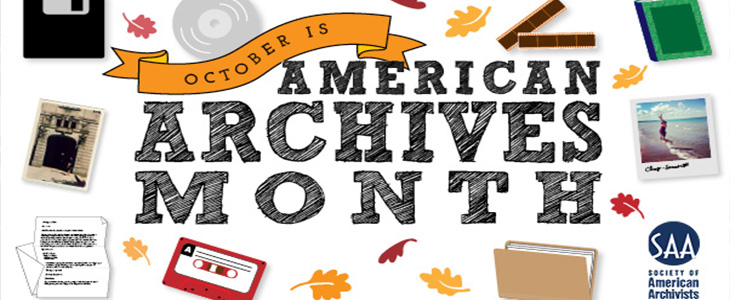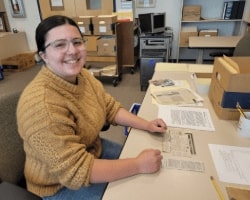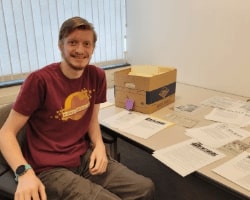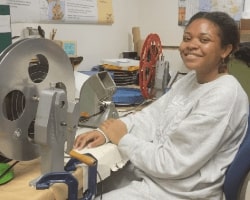October 2024 is American Archives month

Every October archivists celebrate American Archives Month, a time to help the public learn more about archives and what archivists do. Archivists can also create or renew positive connections with community members. Archives may sponsor activities such as s #AskAnArchivist Day, which is when you can contact an archivist to ask your burning historical or genealogical research question, tour archives, or enjoy special archival programs or exhibits.
As part of American Archives Month, we would like to introduce you to archives, archivists, and a primary source that highlights the archives on campus, the Clarke Historical Library, and the students who work there.
What, you may wonder, are archives? Archives are repositories of primary sources or the collections of a large organization or important person. At Central Michigan University (CMU) the Clarke Historical Library is both a special collections library and an archives. The three main topics we collect are CMU History, Michigan History, and Children’s Literature. Michigan history includes documentation of Michigan people, places, and events pre-statehood to today. We collect historical resources on a wide variety of topics and in many formats. You may explore the Clarke’s collections online, but will need to visit in person to see most of the materials.
What are archivists? Archivists are specially trained professionals who care for the archival collections or primary sources. Archivists collect, accession, inventory, organize, rehouse, describe, preserve, and make accessible primary sources. Often the collections arrive in a total mess after decades in someone’s attic, basement, garage or 1990s computer files. It takes time and effort to figure out what is in them. We sort, organize, rehouse, describe, preserve, and make the collections available for the public to access and research in them. We also professionally advise those who wish to retain control of their own archives. Archivist Marian Matyn noted, “I LOVE being an archivist. I LOVE history. I learn something new every day.”
Primary sources are the raw stuff of history, direct from whoever created them, documenting what they saw, felt, heard, or did at a moment in time. There is only one original, and they are not mass-produced like secondary sources (like magazines and books). Examples include letters, diaries, photographs, home movies, committee minutes, architectural drawings, music, maps, reports, and project files. Primary sources come in a wide variety of formats, including modern and archaic, such as: Paper, skin, film, metal, wax, reel-to-reel tapes, home movies, photographic negatives, microcassettes, text messages, emails, websites, and digital images. The creator may be a person, family, or an organization like a club, department, committee, or military or governmental unit.
For Archivist Marian Matyn, one of her favorite aspects of her work is helping train, supervise and mentor CMU students in the archives. Most of them have no archival experience. Marian introduces them to the Clarke and archives in general, and specifically to learn archival skills and theory. Student employees start with small collections, and when they gain skills and confidence, they move to larger and more complex collections, whether that is papers, photographic materials, or moving image films. As an archives processor, they gain or hone practical, hands-on application of archival ethics and theory. Critical thinking, archival appraisal, organizational, rehousing, writing and description skills are components of archival work. They work on some projects individually and others collectively. Film students also learn how to operate film projectors, splicers, and viewers.
These skills help the student employees on their career and academic paths and inform their professionalism. They learn skills that employers want in employees. Marian stated, “I am privileged and humbled to help student workers move forward with their lives and goals, prepared with necessary skills that may translate to other professions.”
Not only do the archives students gain necessary skills and experiences, but they help Marian and the Clarke accomplish their goals. Besides processing and describing primary source collections, some students plan, remove, and reinstall rotating exhibits of the Olga Denison Indigenous Art Collection. They also inspire Marian with their interests, enthusiasm, and skills. The students help Marian process and describe the majority of the Clarke’s primary source collections. Marian said she is grateful for their work and so proud of them!
This semester, Natalie and Matt are processing and describing paper-based and audio-visual collections, while Kenndall and Max are processing and describing Channel 9 & 10 News films from the 1970s. Each of them wrote a short paragraph about their jobs in the Clarke archives.
Natalie Armstrong
“I am a junior at CMU and am double majoring in Anthropology and Art History, with a minor in Museum Studies. As part of my work at Clarke, I processed, described, and encoded finding aids for several collections, including CMU Honors, and the Dumas Family collection. I also worked collaboratively with other students to process, describe, and encode CMU Athletics. I am currently processing part of the C.S. Bliss collection. My favorite collection to work with was the Dumas Family collection, which contains papers, photographs, and newspaper clippings from a Mt. Pleasant area family. The photographs in the collection were very interesting, as they are in multiple formats, including ambrotypes, tintypes, and color photography. Taking part in processing these collections has given me so much appreciation for the work of archivists and taught me many invaluable lessons. I learned how to handle historical materials, how to properly store materials of different mediums, and how to create and encode a finding aid to make materials as accessible as possible to the public. I have no doubt that what I have learned working for Marian at the Clarke will be helpful in my future career, and it already provides me with a unique perspective during my classes.”

Matt Black
I’m a senior at CMU. I am a triple major in Anthropology, Public History, and Mathematics and I have a certificate in Native American Studies. Although my dream job is to be an archaeologist, I took an internship that developed into a job at the Clarke because who doesn’t want a job where you look at cool old documents every day? During my time here, I helped process several collections including past CMU Athletics files, a collection of book auction catalogues related to fly fishing, the family history of a CMU alumni, and photographs from a housing construction company. Additionally, I helped create and encode finding aids for those collections. I enjoyed finding a surprising number of similarities between archaeological field work and archival processing! Both require some repetitive (sometimes mundane) processes, the ability to subjectively group materials together, and rely heavily on context and documentation of methodology. I learned so much in my time at the Clarke and take joy in knowing I am making these materials available to the public.”

Kenndall Wallace
“I’m a senior at CMU majoring in Broadcast and Cinematic Arts with minors in Art and Art History! At the Clarke, I work primarily with 9 & 10 archival news footage, helping to describe and preserve film from the mid-late 20th century. Since my freshman year I’ve worked here, and every year has been an absolute blast! I’ve seen all sorts of footage, from forest fires to football games; and learned firsthand how important it is to keep and preserve physical copies of historical media. Working in the Clarke is easily one of my favorite jobs I’ve ever had and being able to work so closely with film, as well as help preserve it for the future, has been an invaluable experience.”

Max Maksymowski
“I'm a sophomore at CMU and am majoring in Broadcasting and Cinema Arts with a minor in Technical Theater . In the Clarke, I work with moving image film to make sure that it is stabilized for storage as well as watching and describing the film so that researchers can find what they're looking for in the film. Before coming to work at the Clarke, I knew nothing about archives and moving image films, and now I know plenty about the day-to-day intricacies that come with working in a historical library and archives. More specifically, I understand the challenges that come with working with old equipment. Recently, Marian and I had an issue with the film projector where the light would not turn on. We changed the lightbulb, all the fuses, then the lightbulbs again (once we got new ones)., None of those efforts fixed the issue. Marian finally had the idea to change out the piece of plastic holding the fuse in place, and that finally worked.”
